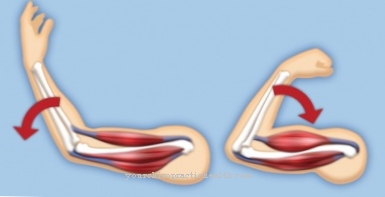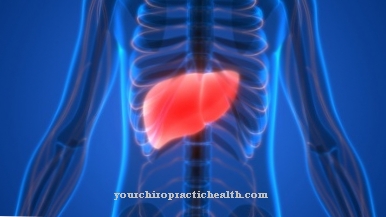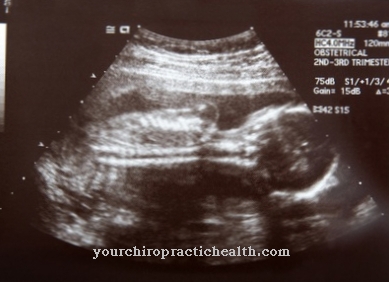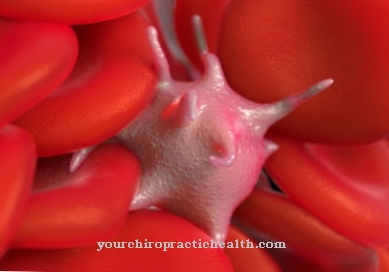A Decarboxylation generally represents the splitting off of carbon dioxide from an organic acid. In the case of carboxylic acids the splitting off takes place very well through heating and enzymatic reactions. Oxidative decarboxylation plays a particularly important role, which leads to acetyl-CoA in the body when pyruvate is broken down and to succinyl-CoA when α-ketoglutarate is broken down.
What is decarboxylation?

Decarboxylation plays an important role in metabolism. The term decarboxylation describes the splitting off of carbon dioxide from organic molecules. A so-called carboxyl group already exists within the molecule, which can be split off by the action of heat or enzymatic reactions.
The carboxyl group contains a carbon atom which is connected to an oxygen atom by a double bond and to a hydroxyl group by a single bond.After carbon dioxide has been split off, the carboxyl group is replaced by the hydrogen atom of the hydroxyl group. For example, carboxylic acids are converted into hydrocarbons.
When carbohydrates, fats and proteins are broken down, the overall balance of catabolic metabolism creates carbon dioxide, water and energy. The released energy is temporarily stored in the form of ATP and reused for biological work, heat generation or for building up the body's own substances. The decarboxylations of pyruvate and α-ketoglutarate are of enormous importance in the context of metabolism.
Function & task
Decarboxylation takes place constantly in the human organism. An important substrate is pyruvate, which is decarboxylated with the help of thiamine pyrophosphate (TPP). This creates hydroxyethyl TPP (hydroxyethyl thiamine pyrophosphate) and carbon dioxide. The enzyme responsible for this reaction is the pyruvate dehydrogenase component (E1).
Thiamine pyrophosphate is a derivative of vitamin B1. The resulting hydroxyethyl TPP complex reacts with lipoic acid amide to form acetyl dihydroliponamide. Thiamine pyrophosphate (TPP) is re-formed in the process. The pyruvate dehydrogenase component is also responsible for this reaction.
In a further step, acetyl dihydroliponamide reacts with coenzyme A to form acetyl CoA. The enzyme dihydrolipoyl transacetylase (E2) is responsible for this reaction. Acetyl-CoA represents the so-called activated acetic acid. This compound flows into the citric acid cycle as a substrate and represents an important metabolite for both anabolic and catabolic metabolism. The activated acetic acid can be broken down into carbon dioxide and water or into important biological substrates implemented.
A metabolite that already comes from the citric acid cycle is α-ketoglutarate. Α-Ketoglutarate is also converted through similar reactions with the elimination of carbon dioxide. The end product succinyl-CoA is created. Succinyl-CoA is an intermediate product in many metabolic processes. It will continue to be implemented as part of the citric acid cycle. Many amino acids only enter the citric acid cycle via the intermediate stage succinyl-CoA. In this way, the amino acids valine, methionine, threonine or isoleucine are integrated into the general metabolic processes.
Overall, the decarboxylation reactions of pyruvate and α-ketoglutarate are located at the interface between anabolic and catabolic metabolic processes. They are of central importance for the metabolism. At the same time, the formation of carbon dioxide through decarboxylation is included in the general carbon dioxide balance.
The importance of oxidative decarboxylation lies in the fact that metabolites result from the metabolism, which can be used to generate energy for the organism as well as to build up the body's own substances. Decarboxylation also plays an important role in the conversion of glutamate to γ-aminobutyric acid (GABA). This reaction, catalyzed by glutamate decarboxylase, is the only way to biosynthesize GABA. GABA is the most important inhibiting neurotransmitter in the central nervous system. It also plays a crucial role in inhibiting the pancreatic hormone glucagon.
Illnesses & ailments
Oxidative decarboxylation disorders can be triggered by a lack of vitamin B1. As already mentioned, vitamin B1 or its derivative thiamine pyrophosphate (TPP) plays the decisive role in oxidative decarboxylation. A deficiency in vitamin B1 therefore leads to disorders of the energy and building metabolism. This results in impairment of the carbohydrate metabolism and the nervous system. A polyneuropathy can develop. In addition, symptoms of fatigue, irritability, depression, visual disturbances, poor concentration, loss of appetite and even muscle atrophy occur. Memory disorders, frequent headaches and anemia are also observed.
The immune system is also weakened by the impaired energy production. The muscle weakness mainly affects the calf muscles. Heart failure, shortness of breath, or edema also occur. In its extreme form, vitamin B1 deficiency is known as beriberi. Beriberi occurs particularly in regions where the diet is very poor in vitamin B1. This applies above all to the population groups who have specialized in nutrition with soy products and husked rice.
Another disease that can be traced back to a disorder of the decarboxylation is the so-called spastic tetraplegic cerebral palsy of type 1. For this disease, in which there is infantile cerebral palsy, the trigger is a genetic defect. A mutation in the GAD1 gene leads to a deficiency in the enzyme glutamate decarboxylase. Glutamate decarboxylase is responsible for the conversion of glutamate into γ-aminobutyric acid (GABA) by splitting off carbon dioxide. As mentioned earlier, GABA is the main inhibitory neurotransmitter of the central nervous system. If too little GABA is produced, brain damage occurs at an early stage. In the case of infantile cerebral palsy, these lead to spastic paralysis, ataxia and athetosis. The spastic paralysis results from the permanently increased muscle tone, which results in a rigid posture. At the same time, the coordination of movements is disturbed in many of those affected, which is also known as ataxia. In addition, in the context of athetosis, there can be involuntary extending and bizarre movements, as there is a constant change between hypotension and hypertension of the muscles.













.jpg)

.jpg)
.jpg)











.jpg)